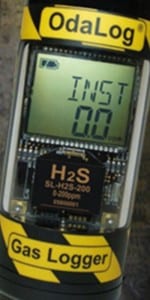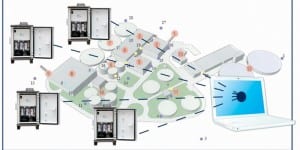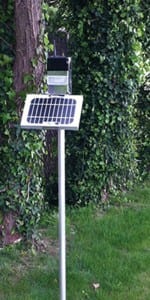Gas monitoring expert a1-cbiss offers a few thoughts on hydrogen sulphide emissions: The problems they present, how best to monitor them, and how such odours are best avoided.
HYDROGEN Sulphide (H2S) is a gas that is present in wastewater applications. It is notorious for its corrosive effects, which are damaging to infrastructure, and the strong egg-like odour that it produces which causes nuisance smells.
Corrosive damage
With H2S in wastewater, the pressing concern is the corrosion that it causes. Initially bacteria oxidises H2S into sulphuric acid on pipes and concrete surfaces. Pipes will become damaged and create leaks causing the wastewater to become diluted.

Repairing pipes affected by this kind of damage can become a hassle, as it is costly and must be prevented from entering sewers. Additionally, if the pipes are located in a residential area then it causes residential grievances.
Nuisance odours
During the warm months of the year, the smell that is produced from H2S becomes even stronger. Wastewater plants situated near neighbouring residential areas often receive complaints about the nuisance odours.
If you are continuously exposed to H2S, damage can be done to the olfactory nerve. In layman’s terms, the senses in the nose are dulled and so the harm which it is doing to your health can pass unnoticed. This is why H2S must be dealt with in a preventative manner – and this requires continuous monitoring and data logging.
Odour abatement
Drainage authorities and water companies carry out odour abatement at wastewater and sewage treatment works where they process sludge and wastewater to control the levels of H2S. This is an extremely septic process and odours must be controlled by a combination of liquid dosing and dry scrubbing technologies.
Liquid dosing is intended to reduce the sulphide levels to an acceptable degree prior to the use of a dry scrubbing system, so that the final scrubbing leaves a gas stream in a non-noxious state.
Gas detection equipment is integrated into a dosing system to log levels of H2S allowing the dosing chemical to increase or decrease in reaction to the H2S levels. This provides a fully automated odour abatement chemical dosing system.

Sewer sensing slip-ups
The challenging conditions present in the sewer network can cause traditional gas detectors to fail. High humidity and increased toxicity may damage or degrade the sensor much more quickly than normal operating conditions. The lifetime of electrochemical sensors can significantly reduce if continuously exposed to target gas in high concentrations. This causes sensor poisoning.
Portable gas logger
Stepping into this breach, a reliable H2S measurement system for sewers is the OdaLog, a portable gas logger designed to be robust, small, and able to log data for extended periods of time, making it a somewhat unique datalogging product. It can be left in situ for up to four weeks. The OdaLog incorporates a bull ring on the top side of the unit, which means a chain or similar can be attached and it can be safely lowered close to the source of H2S emissions, whether it be within sewerage pumping stations or down manholes.
The OdaLog is perfect for data monitoring as its results can easily be captured and displayed using the accompanying OdaStat-G software when hooked up to a laptop or a PC. The OdaLog logs levels of H2S at parts per million (ppm) levels with a resolution down to 0.1ppm.

Boundary monitoring
Nuisance odours that emanate from industrial plants are a problem for neighbouring communities. Wastewater treatment plants must appropriately manage their toxic emissions to reduce exposure to beneath harmful toxic levels.
When complaints are raised by neighbours, sites require gas monitoring data to be able to argue their case for whether or not their process is the cause of the bad smells. To be able to produce these reports, boundary monitoring is deployed along the fenceline surrounding the facility to continuously detect toxic airborne gases at low ppb levels.
Data is transmitted back to a central computer to collate the data and produce these reports.
Real-time measurement
French micro-sensors developer Cairpol now allows real-time measurement of gas pollutants (H2S, O3, NO2, NH3, SO2, CO) with some capable of measuring down to very low ppb concentrations – this kind of monitoring was previously too costly with conventional monitoring systems.
Cairpol’s CairSens technology has ultra low power consumption and can be powered using solar energy in some countries. However a1-cbiss would recommend that the system is mains powered to ensure 24/7 operation.
The Cairpol sensor is compact, autonomous, easy to set up, and can be used reliably in extreme conditions. These sensors can also be networked, bringing the benefits of being able to combine or manage the data from multiple sensors over a large area.






